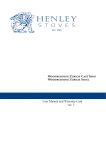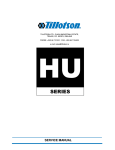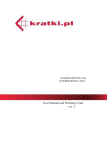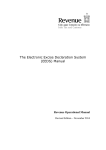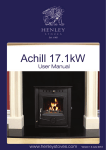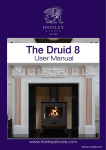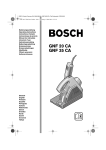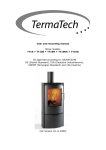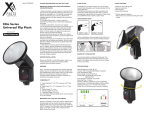Download Manual - Henley Stoves
Transcript
Berlin WOODBURNINNG AB 7kW WOODBURNING AB/S User Manual and Warranty Card ver. 2 EN NOTE! To prevent the risk of fire, the unit has to be installed in accordance with the applicable standards and technical rules indicated further in this user manual. Its installation should be carried out by professional and skilled workforce. The unit is EN 13240 compliant and CE certified. Always observe the laws applicable to the place of installation. First make sure that the flue is suitable. General The unit has to be installed in accordance with applicable building standards. The stove has to be placed within a safe distance from all combustible products. It may be necessary to protect the wall and materials around the stove. The unit has to rest on a solid, non-inflammable foundation. The flue has to be tight, and its walls smooth; before connection, it should be cleaned of soot and all impurities. The connection between the flue and the unit has to be tight and made from non- inflammable materials and protected against oxidisation (enamel or steel flue pipe). If the flue produces weak draught, a new piping system should be considered. It is also important that the flue do not produce excessive draught; a draught stabiliser should then be installed in the flue. Alternatively, special flue endings can also be used to control the strength of draught. You should have the flue pipe checked by a master chimney sweep, and modifications, if any, should be made by an authorised company so as to ensure compliance with PN-89/B-10425. Flue connection examples Flue Non-inflammable material Grout Rosette Cleanout Flue connection diameter The freestanding stove should be placed on a non-inflammable foundation with a sufficient loadcarrying capacity. If the foundation is not suitable for supporting the stove’s weight, appropriate steps have to be taken to improve the load-carrying capacity of the foundation (e.g. use plates that distribute the load across a larger area). The freestanding stove should be connected to a self-dependent (exhaust gas) flue. The freestanding stove uses air for its operation, therefore it is necessary to ensure proper ventilation in the room where the unit is installed. The inlet gratings of the ventilation system should be protected against spontaneous closing. 7 First Lighting NOTE! - during the first lightings the unit should work in slow mode to allow normal expansion of its parts - knobs and other handles are warm when the stove is operating Acrid smoke and burning smell issued from the room heater during the first lightings should not be of concern – this phenomenon is caused by the burning of the paint on various parts of the unit (paint polymerisation). All stickers and accessories should be removed from the ashpan and hearth before the first lighting. The minimum temperature should be maintained and the door should be set slightly ajar (approx. 1- 2cm) when the stove is lit for the first time so that the packing material could combine with the varnish. All the materials have to slowly adapt to high temperatures. During the first several lightings the stove produces an unpleasant smell caused by paint burning. So long as the smell is present, the room where the stove is installed should always be ventilated. Important: Before lighting a big fire, you should try a small one for two or three times. This will help the stove structure to settle properly and the paint to become hardened. The hearth should not be entirely filled up with wood; the fuel amount is optimal when it fills up the combustion chamber up to approx. one-third of its capacity. Before stoking up the fire wait until the flames faint; do not put wood on the glowing embers when they are too hot. Fuel: Considering how our equipment is designed, the recommended fuel that can be used is wood such as oak, hornbeam, ash and beech. Brown coal briquette can also be used. The best fuel is seasoned wood (seasoned in a well-ventilated and dry place for at least one year) in cut and split logs. Coniferous wood is not recommended as the ignition is too intense. Fresh or poorly dried wood is not a good fuel because of its limited energetic properties. Burning such wood can result in increased emission of creosote that collects in the flue pipes. Minerals (e.g. coal), tropical wood (e.g. mahogany), chemicals or liquid substances such as oil, alcohol, petrol, naphthalene, laminated or impregnated boards, compressed pieces of wood bound with glue or rubbish cannot be burnt in such equipment. If another fuel is permitted, such information will be included in the rating plate. General Diagram of the Freestanding Stove exhaust outlet (up, down) secondary air control door window/glass handle primary air control 8 Safety Whenever you take any action with regard to the operation or maintenance of the stove, you should bear in mind that its cast iron components may be hot, so you should wear protective gloves. When operating or maintaining the stove, you should follow the rules that ensure basic safety conditions: - read the instructions for use of the fireplace insert and strictly comply with its provisions; - the stove should be installed and put into service by a properly qualified installer; - not leave any objects vulnerable to temperature near the stove window, do not use water to extinguish the hearth fire, do not operate the stove when the glass is cracked and do not leave any combustible components near the stove; - objects made from combustible materials have to be at least 1.5m away from the hearth; - keep children away from the stove; - have all repairs carried out by a qualified installer and use spare parts supplied by the stove’s manufacturer; - it is not allowed to make any modifications or change the installation or operation rules without the manufacturer’s approval. For the operational safety of the stove, it is recommended to remove its handle during operation. Determination of the minimum flue draught for the nominal thermal power [Pa]: The flue draught should be as follows: - minimum draught - 6 ± 1Pa; - average recommended draught - 12 ± 2Pa; - maksimal draught - 15 ± 2Pa. General The flue has to be properly cleaned and maintained for the stove to work in a correct and safe way. How often it should be cleaned and maintained depends on how well the stove is insulated and which type of wood is used. The use of non-seasoned wood with a humidity of more than 20% or coniferous wood poses a risk of soot fire in the flue due to a thick layer of inflammable creosote, which should be removed on a regular basis. If not removed, the creosote layer inside the flue insert damages the packing and leads to corrosion. The components of the freestanding stove that are made from cast iron include: upper plate, lower plate, rear wall, side walls, left and right grates, door frame, door, exhaust outlet, lid, leg, fence, rear cover, side cover and deflector. Operation - Always observe the user manual; - During the first lightings use only moderate amounts of wood to ensure the proper operation of the entire system. Gradually increase wood batches on subsequent days; - Do not use the unit to incinerate rubbish or waste; - Use only the recommended fuel – SEE ThE rATING PLATE (at the end of the user manual – technical parameters of the unit); - Do not use the stove if the glass is broken or cracked. Replace the glass before reuse. You had better contact the unit’s vendor for this purpose. It is recommended to replace the glass and door gaskets when replacing the glass. Do not tighten the screws too closely so that the glass could freely expand; - After prolonged stoppage make sure that the flue, the connecting pipe and the exhaust system of the unit are open. Technical Parameters See the rating plate, complete documentation – www.kratki.eu Maintenance rules The way in which the fireplace is operated and the quality of the wood used for burning have a fundamental impact on the phenomena occurring inside the hearth. Therefore, it is necessary to check and maintain the stove and its components on a regular basis. Before each heating season you have to inspect and clean the whole stove. 9 Particular attention should be drawn to the condition of the gaskets; they should be replaced if necessary. To reduce creosote accumulation, it is recommended to set the hearth from time to time to the maximum combustion while leaving the door closed. To clean the flue, use only the equipment intended for this purpose. The user is obliged to clean the flue in accordance with applicable laws. NOTE! Heat-proof paint is not resistant to humidity. Ash removal The ash does not spill out if the ashpan is emptied on a regular basis. Do not allow the ash to touch the grate bottom (this prevents air flow that is necessary for combustion). The ash should be poured into a metal container with a tight lid. Glass Cleaning The glass heats up to high temperatures; it can be cleaned only when the stove is put out. Do not use abrasive materials for this purpose. The window is made from special glass that is resistant to temperatures of up to 800°C during continuous burning. Every time close the door using the handle. Do not light the fire too close to the glass. Do not use combustible liquids, fat or any other unsuitable products to facilitate lighting. It is recommended to remove the handle for the safety of the insert’s user. NOTE! From time to time lubricate the abrasive surfaces of the door hinges and the locking device with graphite grease. WArrANTy TErMS AND CONDITIONS Scope of Warranty: The manufacturer warrants the efficient operation of the unit in accordance with the technical and performance specifications contained in this warranty. The use of the stove, the way in which it is connected to the piping system and the operational conditions have to be as described in this user manual. The unit should be installed by a properly qualified professional. The warranty includes free repair of the unit within five years after its purchase. Warranty claims can be raised starting from the purchase date of the unit. They expire on the last day of a product’s warranty period. The warranty does not include: - grate and glass; - defects caused by mechanical forces, contamination, modifications, alterations, maintenance and cleaning of the unit, accidents, chemical agents, weather (discolorations, etc.), inappropriate storage, unauthorised repairs, transport with a forwarding company or by post, improper installation or operation of the unit. Warranty claims will be rejected in the cases above. For all our inserts it is forbidden to use coal as a fuel. In each case firing coal invalidates the warranty for the hearth. When reporting a warranty defect the customer is obliged to sign a declaration that they have not burnt coal or any other unauthorised fuels in our insert. If the use of the said fuels is suspected, the fireplace will be examined for the presence of unauthorised substances. If the examination shows that such substances have been used, the customer loses all warranty rights and is obliged to pay all costs related to the complaint (including the cost of the examination). If another fuel is permitted, the relevant information will be included on the rating plate. The customer can exercise their rights through: - free repair or replacement of parts recognised by the manufacturer as defective; - elimination of any other defects found in the unit; - the concept of ‘repair’ does not include the actions described in the user manual (maintenance, cleaning) which the user is obliged to take on their own; - complaints raised within the warranty period will be processed by the manufacturer free of charge within 14 days after the complaint is reported provided that once properly completed this warranty card and if the card is not available, a receipt showing the purchase date of the product concerned, 10 is supplied together with the defective equipment. The warranty card is valid if: - it has been properly completed and shows the purchase date, seal and signature; - the purchase date shown in the warranty card is the same as that shown on the receipt or a copy of the invoice. Automatic Air Supply System (ASDP) – SystemThe bimetal based, self-regulating thermostat automatically controls the supply of air to the hearth, and consequently controls the combustion temperature inside the freestanding stove. Before lighting the stove set the opening angle of the thermostat so as to ensure free air flow to the hearth and open the air inlets in the door and on the stove front.. It is recommended to open the thermostat initially (through experimentation) at 60%; then you will obtain an optimal combustion temperature for a 3,5 - 4kg large batch of wood. Once the batch is lit close the air inlets in the door and on the stove front. As the temperature in the fireplace is growing, the thermostat starts to perform its function: while closing gradually, it reduces the amount of air in the combustion chamber. When the optimal temperature of 300°C is reached, air supply is largely reduced, resulting in the stove’s temperature falling down until the minimum temperature necessary to maintain the fire is achieved. When the temperature drops below 250°C, air supply starts to be automatically opened and combustions becomes more intense once again. To obtain a higher combustion temperature, you should set a larger opening angle of the thermostat before lighting the stove. When the thermostat is in place, you can reduce the amount of wood needed to burn by 30% as compared with the stove without an automatic combustion control system. In addition to wood savings, this solution improves the comfort of the stove’s use; there is no need to keep checking and adjusting air supply in the door and on the stove front to maintain proper combustion: the thermostat will do this for you. SPArE PArTS If after many years some parts have to be replaced, please contact the vendor or any representative of our company. When ordering spare parts, please name the details from the rating plate shown on the reverse side of the warranty card, which should be retained even after the expiry of the warranty period. Having these details and our factory documentation, the vendor will be able to supply all spare parts within a short time and proceed with repairs as part of their responsibilities. NOTE: Cracks that may occur in vermiculite boards are natural for this type of material and do not affect its utility values. NOTE: Do not use any air exhaust equipment in the room where the stove is installed (as required by Polish laws). MANUFACTUrEr KRATKI.PL declines all liability for damage caused by the user’s modifications of the unit and the remaining piping system. To continually improve the quality of its products, KRATKI.PL reserves the right to alter its equipment without prior notice. 11 VENDOR Vendor’s seal and signature: Name: Address: Tel/fax: Purchase date: STOVE PURCHASER The standalone stove should be installed by a properly qualified installer in accordance with national laws and regulations and the user manual. Date and purchaser’s legible signature: I declare that the manufacturer cannot be held liable for any warranty claims if after reading the user manual and warranty terms and conditions I fail to comply with the provisions contained in them. STOVE INSTALLER Installer company’s name: Installer’s address: Telefax: Commissioning date: I acknowledge that the stove installed by my company meets the requirements of the user manual and has been installed in accordance with applicable standards in this Installer’s seal and signature: respect, as well as building and fire protection regulations. The installed stove is ready for safe use. 41 FLUE INSPECTION RECORD 42 Inspection when installing the stove Date, signature and seal of the chimney sweeper Date and chimney sweep’s seal and signature Date, signature and seal of the chimney sweeper Date and chimney sweep’s seal and signature Date and chimney sweep’s seal and signature Date and chimney sweep’s seal and signature Date and chimney sweep’s seal and signature Date and chimney sweep’s seal and signature Date and chimney sweep’s seal and signature Date and chimney sweep’s seal and signature Date and chimney sweep’s seal and signature Date and chimney sweep’s seal and signature Date and chimney sweep’s seal and signature Henley Stoves, Curraheen, Tralee, Co. Kerry, Ireland Tel: 066 7119788 | Fax: 066 7124200 | Email: [email protected] | www.henleystoves.com










